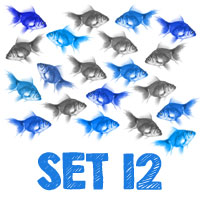![]()
Signs That Are Close... But Not the Same - Iconic Signs
This article is part of our “Signs That Are Close... But Not the Same” series, which highlights signs that look similar, but have different meanings.
The ASL signs shown below look similar, but are not the same. There are many ASL signs that when produced look similar, but in fact have a completely different meaning. Below you will find examples of such signs. Watch closely to see if you can see the differences. In addition, watch my eyebrows, look to see when I tilt my head or lean my body in a certain way, even what my mouth is doing. These nuances are called inflections and trust me, inflections matter.
These examples are all iconic signs. Iconic signs are signs that look how you might think they are signed – their form looks like their meaning.
1. Type vs. Piano
TYPE and PIANO look similar because they both use bent 5 handshapes with the palms facing down. The hands are also similarly spaced and have movement in front of the body.
Paying close attention to the movement and the context in which they are used will help you tell the difference between these two signs. These signs are great examples of iconic signs and look like you think they would. TYPE looks like you are typing on a computer keyboard and PIANO looks like you are playing a piano with a sign-songy, swaying motion.
 |
2. Pencil vs. Write
The dominant hand in the X handshape (representing the writing utensil) is used to make a writing movement on top of the non dominant open B handshape (representing the paper) when signing both PENCIL and WRITE. However, you can watch for the X handshape starting at the mouth when signing PENCIL, which is reminiscent of the past when the tip of writing utensils had to be moistened before they could be used to write. You will also notice that PENCIL has one movement across the palm, while WRITE uses a writing movement.
 |
3. Ice Cream vs. Microphone
Don't blink or you might be confused between these two signs! Likely, the context will help you out... after all, it's unlikely someone's favorite microphone is chocolate!
ICE CREAM and MICROPHONE both use the dominant hand in the S handshape, palm facing sideways, in front of the mouth. ICE CREAM has a repeated downward motion, like what you might make when holding and eating an ice cream cone.
You do NOT need to stick out your tongue or mimic licking ice cream when signing ICE CREAM, however, there should be mouth movement when signing MICROPHONE.
 |
4. Telephone vs. Cell Phone
Since a cell phone is a telephone, you can use the sign for telephone for both CELL PHONE and TELEPHONE. However, a more specific sign has evolved and is now widely used for CELL PHONE.
Both signs have the dominant hand at the side of the face, similar to holding a phone to your ear. The dominant hand when signing TELEPHONE uses the Y handshape and CELL PHONE uses the C handshape.
 |
5. Telephone vs. Call
TELEPHONE and CALL (as in "to call someone by phone") both use the dominant hand in the Y handshape by the side of your face, but TELEPHONE taps twice towards the face, while CALL moves away from the face. You can remember the difference between these two signs because TELEPHONE is like the motion of bringing a phone to your ear when you are ready to make a call and CALL moves away from your body, indicating that you are calling someone else.
 |
6. Tree vs. Deaf Applause
Both TREE and APPLAUSE (as in "deaf applause") use the hands in the 5 handshape raised vertically and the hands make a twisting motion.
For TREE only the dominant hand is in this position (symbolizing a tree) and rests on top of the horizontal non dominant hand with the palm down (symbolizing the ground). When signing this, you can think of a tree planted in the ground, with its branches (your hand / fingers) twisting in the wind.
APPLAUSE uses both hands and you can think of this sign as being like waving your hands in the air so that Deaf people can see your admiration.
 |
How can I figure out the difference between signs on my own?
If you see two signs that look close, but not the same, and you’re not sure, you may use Signing Savvy features to help you figure out the difference. All of our signs have sign descriptions and memory aids that members may access. Reading the sign description and memory aids for the signs will help you figure out the small differences between them that your eyes don’t catch at first. We also recommend using the pause and slow motion feature to slow down the video, so you may take a closer look. These features are available to Signing Savvy members.
ADVERTISEMENTS
 Brenda Cartwright is a Coda, seasoned interpreter, a master teacher, well known presenter, and author of several best selling sign language and interpreting textbooks from the RID Press. For 35 years Brenda was the Chair of the Sign Language Interpreter Program at Lansing Community College in Lansing, Michigan.
Brenda Cartwright is a Coda, seasoned interpreter, a master teacher, well known presenter, and author of several best selling sign language and interpreting textbooks from the RID Press. For 35 years Brenda was the Chair of the Sign Language Interpreter Program at Lansing Community College in Lansing, Michigan. Signs That Are Close... But Not the Same - Set 8
Signs That Are Close... But Not the Same - Set 8 Signs That Are Close... But Not the Same - Set 12
Signs That Are Close... But Not the Same - Set 12 Signs That Are Close... But Not the Same - Alphabet
Signs That Are Close... But Not the Same - Alphabet







